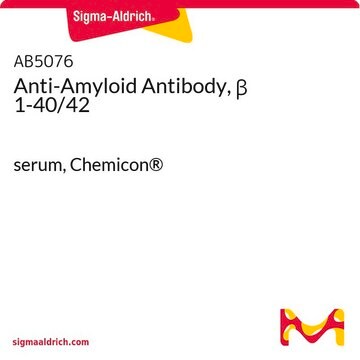일반 설명
Microtubule-associated protein tau (UniProt P10636; also known as Neurofibrillary tangle protein, Paired helical filament-tau, PHF-tau) is encoded by the MAPT (also known as TAU, MAPT1, MTBTL) gene (Gene ID 4137) in human. In Alzheimer′s disease (AD) pathology, accumulation of the microtubule-associated protein tau takes place primarily in the neurons. Tau accumulates in both the somatodendritic and axonal domains of neurons. Tau also accumulates in the soma as neurofibrillary tangles (NFTs). Cell death and synaptic lesions occur independently of NFT formation, and research indicates that NFT formation alone is insufficient for neurodegeneration, suggesting that soluble tau aggregates may be the more toxic and pathologically significant tau species. Tau oligomers are neurotoxic when applied extracellularly to cultured neuronal cells, and tau oligomers (but not fibrils) induce neurodegeneration and synaptic and mitochondrial dysfunction in vivo. Moreove, researchers are able to use tau oligomers as a reliable biomarker to differentiate AD brains from age-matched non-AD brains.
특이성
Clone TOMA-1 (a.k.a. clone H12C10) is among more than 13 hybridomas derived from mice immunized with in vitro generated recombinant Tau-441 (Tau-F, Tau-4, 2N4R isoform) oligomers. These TOMAs are reported to specifically detect oligomeric tau without any significant reactivity toward monomeric tau, tau fibrils, Aβ oligomers, Aβ fibrils, or α-synuclein oligomers (Castillo-Carranza, D.L., et al. (2014). J. Neurosci. 34(12):4260-4272).
면역원
Recombinant human Tau-441 (Tau-F, Tau-4, 2N4R isoform) oligomers (Lasagna-Reeves, C. A., et al. (2012). FASEB J. 26(5):1946-1959).
애플리케이션
Anti-Tau, oligomeric, clone TOMA-1, Cat. No. MABN819, is amouse monoclonal antibody that targets tau oligomers and has been tested in Dot Blot, ELISA, Immunofluorescence, Immunohistochemistry, Neutralization, and Western Blotting applications.
Research Category
Neuroscience
Western Blotting Analysis: 20 µg/mL from a representative lot detected upregulated oligomeric tau in soluble PBS brain extract from Alzheimer′s diseased (AD) human brain (Courtesy of Sengupta, U., et al., Kayed lab, University of Texas, Galveston).
Please refer to the following publications regarding the use of TOMA clones in Dot Blot, ELISA, Immunofluorescence, Immunohistochemistry, Neutralization, and Western Blotting applications:
1. Vuono, R., et al. (2015). Brain. 138(Pt 7):1907-1918.
2. Castillo-Carranza, D.L., et al. (2015). J. Neurosci. 35(12):4857-4868.
3. Castillo-Carranza, D.L., et al. (2014). J. Neurosci. 34(12):4260-4272.
품질
Evaluated by Western Blotting in Alzheimer′s diseased human brain lysate.
Western Blotting Analysis: 4 µg/mL of this antibody detected Tau oligmers in 25 µg of Alzheimer′s diseased human brain lysate.
표적 설명
Variable depending on the size(s) of the oligomer(s). Uncharacterized bands may be observed in some lysate(s).
물리적 형태
Format: Purified
Protein A purified.
Purified mouse IgG2aκ in buffer containing PBS without preservatives.
저장 및 안정성
Stable for 1 year at -20°C from date of receipt.
기타 정보
Concentration: Please refer to lot specific datasheet.
면책조항
Unless otherwise stated in our catalog or other company documentation accompanying the product(s), our products are intended for research use only and are not to be used for any other purpose, which includes but is not limited to, unauthorized commercial uses, in vitro diagnostic uses, ex vivo or in vivo therapeutic uses or any type of consumption or application to humans or animals.









